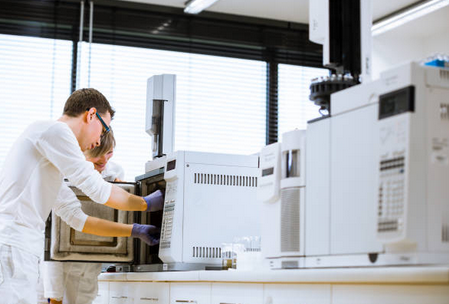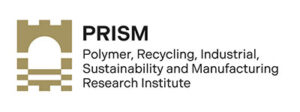Chemical and Surface Analysis
Our laboratory provides a range of polymer techniques for the investigation of the chemical composition of your materials allowing you to have quality control over your feedstock, mitigate the impact of any contaminants and better understand you’re their behaviours. From molecular weight analysis, pyrolysis and GC-MS composition testing to material deformulation, our scientists will help you to understand the composition and chemical properties.
Surface characterization provides a comprehensive approach through several techniques such as SEM and AFM.
Gas Chromatography-Mass Spectrometry (GC-MS Analysis)
Gas Chromatography-Mass Spectrometry provides a quantitative analysis of volatile and semi-volatile organic compounds found in a variety of matrices (gases, liquids and solids) in foods, medical materials, plastics, environmental samples and occupational monitoring samples.
Mass spectrometers are useful for determining the concentration of known compounds and providing identifications of unknown compounds.
- Analysis is sensitive and specific
- Can quantify 2 or more co-eluting peaks of different chemical structures
- Can provide qualitative data as well as quantitative data
- Good starting position for the identification of unknown compounds, odours or initial tests of unknown material contaminants
- Routine analysis of components in mixture
- Cleaning Validation Studies and Trace Analysis
- Purity analysis
- Identification of unknown compounds (e.g. – contaminant materials)
- Volatile materials identification in solid and liquid samples by Headspace GC-MS.
Scanning Electron Microscopy (SEM) with Energy Dispersive X-Ray Analysis (EDX)
SEM provides detailed high resolution images of the sample by rastering a focussed electron beam across the surface and detecting secondary or backscattered electron signal. An Energy Dispersive X-Ray Analyzer (EDX or EDA) is also used to provide elemental identification and quantitative compositional information.
SEM provides images with magnifications up to ~X50,000 allowing sub micron-scale features to be seen i.e. well beyond the range of optical microscopes.
- Rapid, high resolution imaging with identification of elements present
- Spatially resolved quantitative EDX (EDA) analysis of user defined areas on sample surface
- Characterization of particulates and defects
- Examination of grain structure and segregation effects
- Coating thickness measurement using cross sectional imaging of polished sections.
Atomic Force Microscopy with nano Thermal Analysis
Jupiter XR Atomic Force Microscope is the first and only large-sample AFM to offer both high-speed imaging and extended range in a single scanner. Jupiter provides complete 200 mm sample access and delivers higher resolution, faster results, a simpler user experience, and the versatility to excel in both academic research and industrial R&D laboratories.
Coupled with Scanning Thermal Microscopy (SThM) this is a versatile and powerful tool for the characterisation of complex multiphase materials and generates nanoscale thermal images while simultaneously obtaining contact mode images of the topography.
- Higher resolution than any other large-sample AFM
- Extended range 100 μm scanner is 5-20× faster than most other AFMs
- From setup to results, every step is simpler and faster
- Modular design adapts to your needs for maximum flexibility
- Thermal analysis at nano scale
High Pressure Liquid Chromatography (HPLC)
- Routine analysis (quantification and/or comparative identification) of components in mixture
- Cleaning Validation Studies and Trace Analysis
- Purity analysis
Fourier Transform InfraRed (FTIR) spectroscopy
- Identification of materials.
- Detection of intermolecular bonding
- TGA – IR capability
Packaging barrier and degradation testing.
Oxygen and water permeability testing. Respirometer to measure breakdown of polymers in a mimicked environment.
Moisture Analysis
- Mettlor Toledo Halogen Moisture analysis
- % Moisture content of liquid and solid samples by Karl Fischer Coulometer
Imaging Microscope Systems
- Bright light and fluorescence microscope Imaging Systems
- Confocal microscope
- Application of digital sizing software to determine the dimensions of samples
X-Ray Diffraction (Q4 2022)
Non-destructive technique that reveals detailed information about the chemical composition and crystallographic structure of natural and manufactured mater
Equipment
- Fourier Transform InfraRed (FTIR) spectroscopy
- Scanning Electron Microscope System with EDX Detector
- Gas chromatography–mass spectrometry (GC-MS)
- High-temperature Gel Permeation Chromatography (HT-GPC)
- Pyrolysis GC-MS
- High pressure liquid chromatography (HPLC)
- X-ray diffractometer
- Mapping FTIR Microscope
- Oxygen/Water Analyser
- Respirometer
- Environmental and Xenon Arc Test Chamber
- Zeiss CT scanner
- Scanning Electron Microscopy
- Nano Thermal Analysis Atomic Force Microscopy (AFM)
- Optical Microscope

If you require further advice on tensile properties testing please fill in the form below


